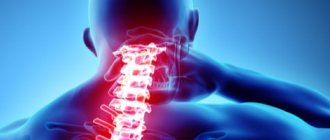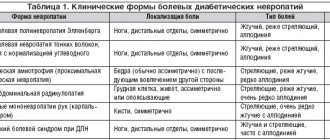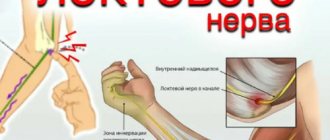Causes of piriformis syndrome
The cause of the syndrome can be various pathological changes in the piriformis muscle - damage, inflammation, fibrotic changes, spasms and an increase in muscle volume. Sometimes intramuscular injections lead to the disease, causing abscesses and the formation of infiltrate.
The main etiological factors of SHM: • Trauma. Piriformis syndrome can be associated with muscle overextension, muscle fiber tears, and fibrosis. In the latter case, the piriformis muscle shortens and thickens. • Post-traumatic hematomas and inflammatory processes – myositis, sacroiliitis, cystitis, prostatitis, endometriosis, prostate adenoma. • Vertebrogenic pathologies. This group includes spondyloarthrosis, osteochondrosis, intervertebral hernia in the lumbar region, spinal and vertebral tumors. As a result of irritation of the fibers of the sacral plexus and spinal roots, a reflex spasm occurs. • Muscle overload associated with prolonged forced position of the lumbopelvic segment. Increased loads occur in cases where, with radiculopathy, the patient tries to take an antalgic position (body position in which pain is minimal). Various sports can cause impairment, including weightlifting and running. • Oncological diseases of the tissues of the sacral region and proximal femur. They cause anatomical changes in structures. Neoplasia can cause spasm of the piriformis muscle. • Asymmetry, which occurs with shortened legs or scoliosis. Sometimes a hip amputation can put the muscle into a permanent spastic state that causes phantom pain.
Prevention of manifestations of SHM
Piriformis syndrome, the symptoms of which interfere with the patient's normal physical activity in everyday life, can be prevented.
To do this, it is important to follow the basic recommendations of doctors on how to prevent pinching of the sciatic nerve and maintain the health of the piriformis muscle:
- observe safety precautions when playing sports and monitor the correct execution of exercises;
- carry out a warm-up until the muscles are completely warmed up before the main loads;
- do not go for long distances without preparation - spasm of the piriformis muscle most often occurs during running;
- when working sedentarily, take breaks and pay attention to a short warm-up;
- develop an even, correct posture and maintain it while walking and sitting;
- Avoid exposure to hypothermia and strong wind in the lumbar and gluteal areas.
Clinical manifestations of piriformis syndrome gradually progress. At the initial stages, the pain is not too intense, but then it intensifies and spreads to the entire surface of the leg.
The best solution is to prevent further development of the syndrome and pay attention to its treatment at the first stage. In the absence of structural anomalies of the piriformis muscle and sciatic nerve, the pain goes away after proper rest and recovery.
Mechanism of development of the syndrome
The piriformis muscle (Musculus piriformis) is attached with its narrow end to the greater trochanter of the femur, and its wide end to the sacrum. It is involved in external rotation and during internal hip abduction, passing through the greater sciatic foramen. The inferior gluteal, sciatic, pudendal and posterior cutaneous nerves, gluteal arteries and veins also pass through this opening. This makes piriformis syndrome a disease that requires a comprehensive systemic approach. Persistent contraction of the piriformis muscle reduces the size of the infrapiriformis foramen. This leads to compression of passing vessels and nerves, primarily the sciatic one. Compression impairs the blood supply to the nerve trunk, being an additional pathogenetic component of sciatica.
Osteopathy offers an alternative to classical medicine and complements it, expanding the understanding of the disease. Osteopaths at the Quality of Life clinic can offer a solution to the problem with the piriformis muscle. Painful sensations that do not have a clear localization often arise as a result of spasm of the muscular-ligamentous apparatus, the causes of which are very diverse. When muscles contract, they move internal organs from their place, disrupt their function and cause pain. This is due to tension, compression and twisting of nerve, blood and lymphatic communications.
Read also
Lumbar spondylosis
Are you bothered by dull and aching pain in the lower back?
Has it become difficult to endure long trips behind the wheel, to stand waiting for your turn, as your lower back “seems to be filled with lead”? According to statistics, one… Read more
Osteoporosis
Systemic bone disease associated with metabolic disorders. With osteoporosis, a decrease in bone mass occurs, a violation of the internal structure of the bone, its frame, as a result of which the bone becomes...
More details
Thoracalgia
Thoracalgia is pain localized in the chest, the intensity of which varies from dull, aching to sharp, sharp pain. Sometimes the pain can radiate to the neck, lower jaw, back, one...
More details
Thoracic osteochondrosis
Thoracic osteochondrosis is a disease in which degenerative processes develop in the intervertebral discs of the thoracic spine. This disease does not occur very often (compared to...
More details
Osteoarthritis of the facet joints
Osteoarthritis of the facet joints occurs due to wear and tear in older people, as a result of overload, incorrect movements or posture during exercise, and can be a consequence of a sports injury. Usually,…
More details
Classification of piriformis syndrome
Piriformis syndrome has only two forms: • Primary, which occurs due to direct damage. Primary SHM occurs as a result of injuries, myositis, and excess stress. • Secondary. This is the result of prolonged pathological impulses from the sacral or lumbar spine, sacroiliac joint, and small pelvis. Secondary SHM is formed by neoplasms in the spine, pelvic organs and hip joint.
Primary piriformis syndrome is caused by anatomical factors, variations of which may be related to separation of the piriformis muscle or sciatic nerve, as well as abnormal development of this nerve. Among patients with this disorder, less than 15% of cases are due to primary causes. Conventional medicine does not have precise data regarding the prevalence of FMS and does not offer evidence linking the disorder to sciatic nerve abnormalities or other types of sciatica.
The occurrence of secondary piriformis muscle syndrome is associated with the action of aggravating factors, including macro- and microtrauma, long-term accumulation of ischemia and the existence of local ischemia. • The development of piriformis syndrome most often (in about half of all cases) is promoted by trauma to the buttocks, which inflames the soft tissues and causes muscle spasm. This eventually causes compression of the nerve. • Spasms may be associated with muscle shortening caused by changes in leg and lumbosacral biomechanics. This causes compression or irritation of the sciatic nerve. When the piriformis muscle stops contracting normally, it can cause a variety of symptoms in the sciatic nerve area, including pain in the gluteal region and/or the hamstrings, calf, and lateral foot. Microtrauma can be caused by overuse, such as long walking or long distance running, as well as direct compression.
Osteopaths work with the root cause of the disorder, eliminating the problems that caused the development of BMS.
Medical Scientific and Practical Center for Vertebrology and Neuroorthopedics, Professor M.L. Kurganov
is a pain syndrome that is localized in the gluteal region with possible return (irradiation) to the upper thigh, lower leg and groin area.
Piriformis syndrome occurs in at least 50% of patients with discogenic lumbosacral radiculitis. Reflex tension in the muscle and neurotrophic processes in it are caused, as a rule, by irritation not of the fifth lumbar, but of the first sacral root. If the patient is diagnosed with this, the assumption of the presence of piriformis muscle syndrome may arise in the presence of persistent pain along the sciatic nerve , which does not decrease with drug treatment. It is much more difficult to determine the presence of this syndrome if there is only pain in the buttock area, which is limited in nature and associated with certain positions (movements) of the pelvis or when walking.
Occurrence of the syndrome
Piriformis syndrome has been familiar to general practitioners for a long time; it can be a complication of lumbar osteochondrosis, a symptom of diseases of the pelvic organs, and a consequence of overload of the piriformis muscle, muscles and ligaments of the lower extremity girdle.
Primary damage to the piriformis muscle is observed in myofascial pain syndrome; the immediate causes of its occurrence may be:
- stretching
- hypothermia
- muscle overtraining
- injury to the lumbosacral and gluteal regions
- unsuccessful injection of drugs into the piriformis muscle area
- myositis ossificans
- prolonged stay in antalgic position
Secondary piriformis syndrome can occur when:
- diseases of the sacroiliac joint
- diseases of the pelvis, in particular gynecological diseases
With vertebrogenic pathology, a reflex muscle spasm may occur. Piriformis syndrome, which develops according to this pattern (not radicular), with muscle-tonic manifestations, is the most common variant of lumbar and hip pain. Pathological tension of the piriformis muscle in the form of a spasm is observed in discogenic radiculopathies with damage to the spinal roots. In these cases, there will be a clinical combination of both radicular and reflex mechanisms with the occurrence of neurological manifestations of vertebrogenic pathology.
So, it became clear that the causes of piriformis muscle syndrome can be both vertebrogenic and non-vertebrogenic.
Possible vertebrogenic causes include:
- radiculopathy of L1 – S1 roots
- tumors of the spine and spinal roots
- injuries of the spine and spinal roots
- lumbar stenosis
Non-vertebral causes:
- myofascial pain syndrome
- referred pain in diseases of internal organs
Anatomical and biomechanical features of the piriformis muscle.
The piriformis muscle (m. piriformis) is a flat isosceles triangle . At its base, the muscle originates from the anterior surface of the sacrum lateral to the second to fourth sacral foramina. It is supplemented by fibers originating in the greater sciatic notch of the ilium, and sometimes from the sacrospinous ligament. Beginning in the sacroiliac joint capsule, it is the only muscle connecting this joint. The muscle converges and moves outward. Next, its bundles exit the small pelvis through the greater sciatic foramen and pass into a narrow and short tendon that attaches to the medial surface of the greater trochanter of the femur. There is a mucous bursa here. The muscle does not occupy the entire sciatic foramen, but forms an upper and lower gap. The superior fissure is occupied by the superior gluteal artery and nerve. The sciatic nerve and the inferior gluteal artery pass through the inferior fissure. The piriformis muscle is innervated by branches of the sacral plexus, from the S1 and S2 spinal roots. The blood supply comes from the superior and inferior gluteal arteries.
The function of the piriformis muscle is to abduct and externally rotate the hip. At the same time , she extends and abducts the hip , and with a sharp flexor-abduction posture, rotates it . The muscle is involved in “anchoring” the femoral head, similar to the function of the supraspinatus muscle in relation to the head of the humerus. It prevents rapid internal rotation of the hip in the first stage of walking and running. It creates an oblique force on the sacrum; due to its lower part, it provides a “shearing” force to the sacroiliac joint - it pulls its side of the base of the sacrum forward and the apex back. The muscle promotes antinutation (swinging) of the sacrum. If the nutating muscles pull it forward, wedge the sacrum forward, the piriformis pulls its lower sections back towards the posterior sections of the innominate bones.
When the piriformis muscle contracts, its antagonists, the hip adductors, are slightly stretched. They, however, simultaneously rotate the thigh outward, being in this regard a synergist of the piriformis muscle. The gluteus medius muscle partially rotates the thigh inward, it also abducts the thigh, also not being a complete antagonist of the piriformis muscle. Thus, regarding the function of hip abduction, the piriformis agonists are all gluteal muscles, and all the adductors are antagonists. Rotational movements are carried out by more complex muscle complexes.
In 90% of cases, the trunk of the sciatic nerve exits the pelvic cavity into the gluteal region under the piriformis muscle. In 10% of cases, the sciatic nerve pierces the piriformis muscle as it passes into the gluteal region. A prerequisite for compression of the sciatic nerve is induration of the piriformis muscle during its aseptic inflammation. The altered piriformis muscle can compress not only the sciatic nerve, but also other branches of the second to fourth sacral nerves - the pudendal nerve, the posterior cutaneous nerve of the thigh, the inferior gluteal nerve.
Thus, with piriformis syndrome it is possible:
- compression of the sciatic nerve between the altered piriformis muscle and the sacrospinous ligament
- compression of the sciatic nerve by the altered piriformis muscle as the nerve passes through the muscle itself (a variant of the development of the sciatic nerve)
- compression of the branches of the second to fourth sacral nerves - the pudendal nerve, the posterior cutaneous nerve of the thigh, the inferior gluteal nerve
Manifestations of piriformis syndrome.
The clinical picture of piriformis syndrome consists of:
- local symptoms
- symptoms of sciatic nerve compression
- symptoms of compression of the inferior gluteal artery and vessels of the sciatic nerve itself
local symptoms :
- aching, nagging, “brainy” pain in the buttock, sacroiliac and hip joints, which intensifies when walking, standing, adducting the hip, and also in a squatting position
- the pain subsides somewhat when lying down and sitting with legs apart
- with good relaxation of the gluteus maximus muscle, a dense and painful when stretched (Bonnet-Bobrovnikova symptom) piriformis muscle is felt underneath it
- upon percussion at the point of the piriformis muscle, pain appears on the back of the leg - Vilenkin’s symptom
- soreness of the ischial spine is detected: a palpating finger encounters it, intensively sliding medially upward from the ischial tuberosity
- often tonic tension of the piriformis muscle is combined with a similar condition of other pelvic floor muscles - coccygeus, obturator internus, levator anus, etc. in such cases they talk about pelvic floor syndrome
- with piriformis syndrome there are almost always mild sphincter disorders: a short pause before urination begins
symptoms of compression of blood vessels and sciatic nerve in the infrapiriform space:
- pain due to compression of the sciatic nerve is dull, “brainy” in nature with a pronounced vegetative coloring (feelings of chilliness, burning, stiffness)
- irradiation of pain throughout the leg or mainly along the innervation zone of the tibial and peroneal nerves
- provoking factors are heat, weather changes, stressful situations
- sometimes the Achilles reflex and superficial sensitivity decrease
- with the predominant involvement of the fibers from which the tibial nerve is formed, the pain is localized in the posterior group of muscles of the lower leg - pain appears in them when walking, during the Lasegue test; palpation of soreness in the soleus and gastrocnemius muscles is noted
symptoms of compression of the inferior gluteal artery and the vessels of the sciatic nerve itself:
- a sharp passing spasm of the blood vessels of the leg, leading to intermittent claudication - the patient is forced to stop, sit down or lie down when walking; the skin of the leg turns pale; After rest, the patient can continue walking, but soon the same attack recurs.
An important diagnostic test that confirms the leading role in the formation of the clinical picture of the piriformis muscle is its infiltration (piriformis muscle) with novocaine with an assessment of the positive changes that arise.
Certain manual tests help recognize piriformis syndrome:
- pain on palpation of the superior internal region of the greater trochanter of the femur (attachment site of the piriformis muscle)
- pain on palpation of the lower part of the sacroiliac joint - projection of the insertion site of the piriformis muscle
- reproduction of pain during passive adduction of the hip with simultaneous internal rotation (Bonnet-Bobrovnikova symptom)
- test for the examination of the sacrospinous ligament, which allows you to simultaneously diagnose the condition of the sacrospinous and iliosacral ligaments
- tapping on the buttock (on the sore side) - this causes pain spreading along the back of the thigh
- Grossman's symptom - when struck with a hammer or folded fingers on the lower lumbar or upper sacral spinous processes, the gluteal muscles contract
Methods for diagnosing piriformis syndrome.
One of the most reliable methods for diagnosing piriformis muscle syndrome is considered to be transrectal palpation of the piriformis muscle, determined in the form of an elastic, sharply painful cord. It is also possible to palpate the piriformis muscle through the gluteus maximus muscle, with the patient “lying on his side” (Kipervas I.P. Peripheral neurovascular syndromes, M., Medicine, 1985).
An important diagnostic test is infiltration of the piriformis muscle with novocaine and assessment of the positive changes that occur. The final diagnosis can be established when clinical signs improve as a result of post-isometric relaxation of the piriformis muscle (Farit A. Khabirov “Clinical neurology of the spine”, Kazan 2003).
The difficulty of instrumental diagnosis of this syndrome is due to several reasons:
- firstly, the piriformis muscle lies so deep that directly examining it, for example, using myography, is problematic; Ultrasound scanning of the muscle in B-mode is difficult due to the heterogeneity of the intestinal contents above it
- secondly, with piriformis muscle syndrome there is no direct suffering of large and medium-sized vessels, for the study of which Doppler ultrasound is usually used
In October 2004, a method for diagnosing piriformis muscle syndrome was published, proposed by Nefedov A.Yu., Lesov V.O., Kanaev S.P. and Rasstrigin S.N. (Russian State Medical University). This method consists of Doppler recording of blood flow in the arterioles of the 1st phalanx of the big toe and determination of compression of the sciatic nerve, when the spectrum of linear blood flow velocity on the diseased side is determined to be single-phase, and the amplitude of its systolic component is reduced by 30-50% compared to the healthy side . The method allows you to speed up and clarify the correct diagnosis, as well as evaluate the results of treatment.
Principles of treatment.
In most cases , correction is required by the primary condition that caused the formation of muscular-tonic syndrome. When the primary source of pain impulse is eliminated, reflex muscular-tonic syndrome can regress. In cases where muscular-tonic disorders become the main or independent source of pain, both local and general effects are used. Stretching, massage of the affected muscle, warming physiotherapy, and manual therapy techniques aimed at mobilizing the affected spinal motion segment are performed. It is advisable to correct the motor stereotype and avoid provoking loads and poses. In the absence of a sanogenetic role of muscular-tonic syndrome, it is possible to prescribe NSAIDs and muscle relaxants with analgesic properties, for example, tizanidine.
Since painful tension of the piriformis muscle is most often associated with irritation of the first sacral root, it is advisable to alternately carry out novocaine blockade of this root and novocainization of the piriformis muscle . When trying to relax the piriformis muscle, you must first use blockades, a relaxing massage of the gluteal muscles while simultaneously intensively treating the adductors.
Block of the piriformis muscle. The point of infiltration of the piriformis muscle is found as follows. The greater trochanter of the femur, the superior posterior spine of the ilium and the ischial tuberosity are marked. These points are connected and a bisector is drawn from the superior posterior spine to the base of this triangle. The required point is located on the border of the lower and middle parts of this bisector. A needle is inserted here vertically to a depth of 6–8 cm and the muscle is infiltrated with a 0.5% solution of novocaine in an amount of at least 10 ml.
Gymnastic exercises that are recommended to relax the piriformis muscle and activate its antagonists can be performed in the following order. In the supine position with half-bent legs, the soles resting on the couch, the patient makes smooth movements of connecting and spreading the knees. Then, connecting the bent legs, the patient energetically pushes the other with one knee for 3-5 s. The next exercise, the “cradle,” is performed, if possible, without the help of hands while actively flexing the hips. Then, in a sitting position, they spread their soles wide apart, connect their knees and, leaning on the couch with the palm of their outstretched hand, begin to get up from the couch. By the time the palm comes off the couch, the other hand is offered to the instructor, who helps complete the straightening of the body. At this point, the connected knees are freely separated. When the condition improves, during the regression stage and during the period of remission, it is recommended to sit often (but not for long) in the cross-legged position.
The role of spasms in the pathogenesis of piriformis syndrome
Spasm is a protective reaction of the body in the form of sustained tension and muscle contraction. It occurs as a response to threats associated with physical influences (blows, pain) or mental stress (fear, anxiety). When the threat passes, the tension gradually subsides, the tone of the muscles and ligaments is restored. However, this does not always happen.
If the muscle is constantly tense, this leads to compression of the vessels of the circulatory and lymphatic systems, because the tissues do not receive the required amount of oxygen and nutrients. As a result, their hypoxia develops and local immunity decreases, which leads to chronic inflammation. With constant stress over several weeks, fibrosis develops - a hardening of the tissue, which is usually accompanied by severe pain. But even at this stage the situation can still be corrected: the osteopath, having worked with the genitourinary system, the lumbopelvic region, and the dura mater, will eliminate spasms of muscles and ligaments and return them to their original tone. However, with very long spasms (more than a year), irreversible tissue scarring processes begin, resulting in ossification (calcification) of the muscle or ligament. Considering that spasm can be caused even by a visit to the gynecologist, not to mention childbirth or abortion, the scale of this problem in women is amazing.
The role of this muscle in ensuring the normal functioning of a woman’s body is great. Spasms and fibrotic phenomena often cause dull aching pain of different localization: • sacral; • lumbar; • gluteal.
They often intensify during squatting. In addition, spasms can be an additional risk factor for the development of a number of other pathologies - in particular, hemorrhoids and arthrosis of the hip joint.
Muscle spasms and fibrosis can also cause difficulties during labor. This is due to the fact that the birth canal fits tightly to the sacrum, so the contractions of the Musculus piriformis play an important role in the birth of the child, pushing and turning the fetal head. If the muscle is fibrotic, the fetal head stands in one position for a long time. This is fraught with damage to soft tissues and a number of other complications.
On the other hand, Musculus piriformis itself is injured during childbirth, which can cause fibrosis in the postpartum period. Therefore, every woman should visit an osteopath before and after childbirth. Voltage is easily determined during examination. Osteopathic techniques gently and painlessly eliminate spasm, and exercise therapy doctors will teach the patient the correct technique of exercises to strengthen the hips, back, buttocks and abs, and normalize the position of the lumbopelvic region.
We have considered only a small part of the situations and problems associated with internal spasms of the piriformis muscle. Each organ is supported by several muscles and ligaments, each of which, in turn, can go into spasm.
Moreover, the consequences are far from limited to pain, but can be much more serious. For example, forced displacement of the uterus during an abortion causes deep spasms of all the ligaments that attach the organ to the skeleton.
Since it does not return to its original anatomical position, sometimes twisting of blood vessels and nerves occurs. In case of a new pregnancy, this can lead to fetal hypoxia and developmental delay.
Osteopathic correction is a soft and delicate effect not only on the source of pain, but also on the true causes of the syndrome. A competent osteopath will help set the body up for self-healing, rehabilitate muscles and internal organs.
Treatment
Therapeutic measures for spasm of the piriformis muscle must be taken as quickly as possible to avoid the rapid development of the disease and to avoid adverse consequences. To eliminate pain, the doctor then prescribes medications, therapeutic exercises, physiotherapy methods and massage. It is recommended to limit physical activity during therapy.
Drugs
The main method of treating piriformis muscle spasm is to eliminate pain.
If there is severe pain, you may need to use anesthetic injections. For this, the doctor will prescribe non-steroidal anti-inflammatory drugs. It is better to use them in the form of intramuscular injections, which speeds up the effect.
The following drugs are usually prescribed:
- Movalis;
- Diclofenac;
- Ketorol;
- Voltaren.
Analgesics may also be prescribed:
- Baralgin;
- Took;
- Tempalgin.
If antispasmodics do not have the desired effect, muscle relaxants, for example, Mydocalm, can be prescribed.
Surgery
Surgical intervention for this disease may be necessary only in the most severe cases, if the patient has developed severe paresis of the feet (in the form of weakness). In this case, a dissection of the altered piriformis muscle is performed, which allows the sciatic nerve to be released.
Exercise therapy and massage
To restore the functions of the damaged muscle, the doctor prescribes a special set of exercises. It is important to perform them calmly, slowly, relaxing and stretching the muscles three times a day. There should be no pain when performing the exercises.
Exercises may be as follows:
- from a lying position on your back, bend your legs, resting them on the bed, do not quickly spread and connect your knees;
- from a sitting position, spread your feet wide, then bring your knees together; leaning your hand on the bed, slowly stand up, and then smoothly spread your knees.
Different types of massage will help alleviate the patient's condition. You can perform self-massage at home on a comfortable mat. A tennis ball is placed on it, which you need to slide on while lying on your side.
If the piriformis syndrome is not complicated by anything, then physical therapy may be used. The painful area can also be lightly massaged in a circular motion. This helps especially well with acute inflammation.
For this disease, effective thermal procedures such as:
- low frequency currents;
- electrophoresis;
- diadynamic therapy;
- laser treatment;
- phonophoresis.
Treatment at home
The following recipes can be recommended from traditional medicine::
- mix valerian, triple cologne, hot pepper and hawthorn, adding ten crushed Aspirin tablets to the mixture. After infusing the product for a week in a dark place, it can be used as a compress;
- Grind the horseradish root and black radish in a blender, add salt and acetic acid; After mixing, remove the components in a dark place for a week. Use only for compresses, keeping on the affected area for no more than a quarter of an hour.
Video: “Exercise to eliminate spasm of the piriformis muscle”
Prevention
In advanced forms, this pathology can pose a great danger to health . Therefore, it is important to regularly undergo preventive examinations, to avoid overstrain in the lumbar spine, and to avoid hypothermia, in order to avoid colds in the back and nerve endings.
Symptoms
In approximately 70%, the gluteal-sacral area is affected first. The pain is constant, often nagging and aching. They intensify during walking, squats, and hip adduction. To reduce discomfort, the patient has to spread his legs to the sides. Over time, pain along the sciatic nerve - sciatica - is added to the symptoms. Shooting marks appear running from the foot to the buttocks. In the area where the SGM is located, pain sensitivity decreases and a burning sensation occurs.
Hypotonia of the muscles of the foot and lower leg gradually develops. With total compression of nerve fibers, “dangling foot” may develop. The main manifestations include intermittent claudication, which is a consequence of vascular compression. The same disorder leads to a decrease in leg temperature, pale skin and numbness of the fingers.
Clinical picture of the disease
The clinical picture of piriformis syndrome includes characteristic signs that occur when the sciatic nerve is compressed by this muscle. Normally, it passes through the sciatic foramen and further innervates the skin and muscles of the lower limb.
However, with anomalies in the structure of these structures, during prolonged physical activity, injuries and muscle spasms, compression of the nerve occurs. This is accompanied by typical clinical signs:
- chronic pain in the buttock area - it spreads along the nerve, to the thigh and lower leg;
- numbness, decreased sensitivity of the skin;
- swelling of the subcutaneous tissues in the buttock, thigh and lower leg;
- increased pain in certain positions: while walking, running or sitting.
A characteristic symptom of the piriformis muscle is pain from a pinched nerve that does not go away after warming up. It becomes most intense when you try to squeeze your hips together or cross one leg over the other.
The discomfort disappears a little if you move your leg to the side while lying on your back - this way the piriformis muscle lengthens, which leads to a decrease in pressure on the nerve.
Possible risks and complications of piriformis syndrome
Constant debilitating pain reduces the patient's ability to work. It can lead to: • emotional lability; • insomnia; • increased fatigue.
Peripheral paresis of the leg and foot caused by the syndrome develop muscle atrophy. With prolonged progression of the syndrome, the changes become irreversible. Persistent paresis leads to disability. Secondary spasm of the pelvic floor muscles is also possible. This causes discomfort when urinating, dyspareunia (pain during sexual intercourse) in women.
Osteopathic treatment
Osteopathic treatment does not just act on the sore spot, but treats the entire body as a whole; the doctor “listens to the body with his hands.” All organs and systems constantly pulsate, and spasms and tensions distort the picture characteristic of the body of a healthy person. The magnitude of these pulsations is insignificant, but is accessible to the sensitive hands of an osteopath.
Having examined these micropulsations, the doctor determines the cause of the syndrome and eliminates muscle tension. Muscle tissues and ligaments are stretched and relaxed, and the doctor uses gentle movements to move organs and tissues to return them to their normal anatomical position.
Osteopathic correction of the bones, muscles and ligaments of the pelvis, as well as the lumbosacral spine, plays a special role in osteopathic treatment. Soft muscular-fascial relaxation of the Musculus piriformis quickly restores the normal state and eliminates the cause of the syndrome - compression of the sciatic nerve and blood vessels. In especially severe cases, the treatment program is supplemented with drug blockade of the brain.
Exercise therapy in the treatment program
After the acute pain syndrome is relieved, the results of osteopathic treatment are consolidated with the help of physical therapy. This allows you to avoid re-exacerbation of the syndrome. Exercises are performed under the guidance of an instructor. The program includes the implementation of special complexes aimed at strengthening: • the muscular corset of the lower back; • buttocks; • lower extremities. Work is also carried out with other parts of the musculoskeletal system.
Treatment of BMS is not aimed at relieving symptoms, but at eliminating the root cause of the syndrome. Therefore, any pain relief without treating the provoking factor is pointless. The exercises that are prescribed to patients are aimed at fully relaxing the muscular-ligamentous system, as well as activating antagonists in the movement of the lumbosacral region








